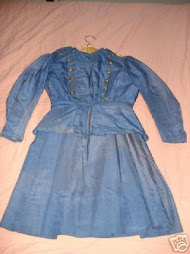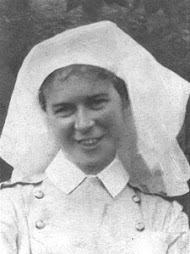Hello again. I'm sorry I haven't blogged for the past few months. My cycle was broken by a death in the family and I am just now getting back to normal with my entries. Today I'm writing about Mary Geraldine McGinnis, a professional nurse who joined the CAMC on March 2, 1918 in London, Ontario, but about whom little is known. What I can tell you for certain is that, according to her military file, she had already served as a nurse for at least a year with the QAIMNS before she joined the CAMC. It was likely that she had served her contract with them and returned home and applied to her own country’s nursing service. This was frequently the case during the war when there were far more nursing positions open in the British service than in the Canadian. However, as the war dragged on, more Canadian hospitals and medical units were established and more opportunities for nurses like Mary to make the transition.
Born on November 13, 1893, Mary was the daughter of Irish-born Philip and Mary McGinnis of 462 Picadilly Street, London, Ontario. Philip was a “traveler,” a type of sales representative. When Mary was eight, the family was well off enough to have a 14-year-old live-in German-born servant named Edith Reeder. However, in 1911 when Mary was eighteen, the servant had disappeared. Mary had six brothers and sisters—Madeline, Hugh, Philip, Charles, John, and strangely enough, another Mary, perhaps explaining why the older Mary was listed in the census under her middle name in 1911.
Mary was Roman Catholic, an anomaly among the mostly Protestant nurses of the CAMC. The 5 feet, 4 ½ inch tall woman had hazel eyes and weighed 130 pounds. And unlike many nurses, she gained a further 10 pounds before she left her nursing service. Mary wasn’t the only McGinnis to enlist, either. Her brother Hugh (born in 1898), an electrician, had enlisted in 1917. He had already attempted to do so once before, but was turned away since he was underage.
Although Mary enlisted in March, she did not go overseas until the war was nearly over, in August 1918. This was probably due to the fact that she came down with scarlet fever in April. After her recovery and before she traveled overseas, Mary prepared a will, signed by a Matron and a nursing sister. The will does not say if they were colleagues in a hospital where Mary had been working or if she may have met them while convalescing. Whatever the case, Mary leaves all of her worldly goods to her mother.
On August 26, Mary traveled overseas where she was posted to the CAMC depot at Shorncliffe. In October, she was transferred to the Canadian General Hospital #16 at Orpington, Kent. She would work there until April 1919, when she returned to Canada. She remained with the CAMC until September 28, 1919, likely caring for convalescing soldiers and influenza victims in the year after the war ended.
There is nothing else to indicate anything further happened to Mary during her wartime service; her demobilization papers are in her military file. However, according to her death record, she succumbed to influenza and heart failure on February 10, 1920 in Speedwell Hospital, London, Ontario. There is also a small card in her military file indicating that on August 18, 1920, her father received the plaque and scroll indicating Mary had died, and her mother was given her service medal. However, Mary must have been seen as having gained her illness from her military service, thus the awarding of the plaque and scroll.
She is buried in St. Peter’s Roman Catholic Cemetery in London, Ontario. If any of my readers know anything more of Mary, and what caused her death, please write to me. It was clear she was a dedicated nurse, whose life deserves more of a memorial than her thin file would indicate.
Subscribe to:
Post Comments (Atom)






















No comments:
Post a Comment